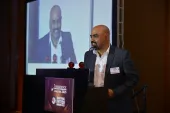
Dr. Henrik Naujoks of Bain & Company: Insurers must shift from damage reimbursement to incentivising risk-reducing behaviours
Naujoks stressed that changing customer behaviour, climate change, and technological disruptions, amongst other factors, are radically altering the insurance industry's risk landscape.
The insurance industry today is grappling with issues such as climate change, evolving consumer expectations, and rapid technological advancements, all of which are reshaping traditional business models. At the same time, these disruptions open up new avenues for growth and transformation, offering insurers the chance to leverage data analytics, artificial intelligence, and digital platforms to enhance customer experiences and manage risks.
Dr. Henrik Naujoks, a Senior Partner at Bain & Company, is a distinguished figure in the financial services sector. With over 30 years of management consulting experience, Dr. Naujoks has been instrumental in leading digital and customer-led transformations across the insurance industry. His extensive global experience has provided him with a broad perspective on the challenges and innovations in insurance. He frequently contributes to prominent publications and speaks at industry forums, bringing his insights to a wider audience.
In our interview with Dr. Naujoks as a judge in the Insurance Asia Awards 2024, he delved into the emerging trends disrupting traditional insurance business models and outlined strategies for insurers to stay competitive in a rapidly changing landscape. He emphasised the importance of leveraging new technologies and data to mitigate risks and enhance customer engagement. Additionally, Dr. Naujoks highlighted the significance of partnerships and collaborations in driving innovation and addressing shared challenges within the industry.
Stay tuned for an in-depth discussion with Dr. Naujoks, where he shares his expert analysis on the future of insurance, the role of technology, and the power of customer-centric strategies.
Given your focus on the reinvention of the insurance industry, what emerging trends do you see disrupting traditional insurance business models and how can insurers adapt to stay competitive in this evolving landscape?
Climate change, disease, ageing populations, and technological disruptions are combining to radically change the risk landscape—both through more risks and different types of risk.
The changes thrust insurance companies into new roles. They have the chance, perhaps even the duty, to take a firmer hand in moving beyond reimbursement for damage and controlling losses to incentivising behaviours in ways that will reduce risks. If they can pull it off, the future of insurance looks bright.
The industry now has the tools to help solve these problems on a large scale by 2030, thanks to improved technology and data. Insurers have always played a role in addressing societal risks—for instance, when they were instrumental in lobbying for car safety belts. Now, new technologies, such as the Internet of Things (IoT) or machine learning (ML), along with massive data sets on health or driving behaviour and other relevant trends, enable insurers to directly partner with customers to identify, prevent, and mitigate each risk event.
Considering your focus on customer-led transformations, how do you believe insurers can enhance their customer experience to stay competitive in an increasingly digital and interconnected market?
Compared to other industries like telecom or retail, insurance is by definition a low-touch product with relatively few “natural” customer touchpoints. Having said this, we see leading insurers investing to become more relevant for their customers. They are actively working on increased engagement. Our research indicates that the number of meaningful interactions correlates strongly with the NPS (net promoter score).
The other megatrend that is fueling customer-led transformation is the availability of data and analytics tools that allow it to become much more targetted and enable personalisation at scale.
Consequently, there is a broad range of levers to enhance the customer experience; let me name a few.
AI and GenAI can be used to enhance the “human in the loop” (e.g. agents, customer service reps, claims adjusters) so that they can come up with more tailored advice at the right time whilst becoming much more efficient.
Offer new services that are relevant in customers’ lives and provide them with a tangible value add (e.g. health-related services, auto/motor services).
Digital is also enabling insurers to get in contact with customers at low cost e.g. providing them with updated information, giving them access to additional services and enabling true omnichannel interactions.
These kinds of initiatives have to be supported by a culture that puts the customer at the core, a system that measures customer feedback but – more importantly – creates a feedback mechanism that allows for individual learning as well as systematic improvements (e.g., processes and products), and a brand that generates trust and enforces the key elements of the insurer’s differentiation.
Could you share your perspective on the importance of collaboration and partnerships within the industry, especially in fostering innovation and addressing shared challenges?
Partnerships are becoming increasingly important and insurers need to build up their respective partnering capabilities. This is true within the industry as well as beyond the insurance sector. Most relevant are the following archetypes of partnerships.
Distribution partnerships. Asia is moving towards a platform economy and one important way to reach the customer is through platforms (e.g. ride-hailing, e-commerce, health platforms). They can be used for lead generation or direct sales (“embedded insurance”). Banca partnerships are another, more established form of collaboration.
Innovation partnerships. Partnerships can play an important role in accelerating innovation at incumbent insurers. This can entail partnerships across the value chain, e.g. with innovative insurtechs that provide great front-end solutions or with tech suppliers that bring new solutions to claims and underwriting.
Delivery partnerships, especially when it comes to enterprise technology we see partnerships with tech providers, that can provide infrastructure as well as point solutions to accelerate the tech transformation of insurers.
Public private partnerships. When it comes to specific high-value risks, the insurance industry should partner with public players in order to create solutions for end-customers (retail and commercial).
From your interactions with industry experts and journalists in leading publications, what are some commonly misunderstood aspects of the insurance industry that you believe need to be addressed?
A few aspects come to mind. Overall, the societal role of the insurance industry is underemphasised. Insurance is crucial for our economies as well as private lives. Still, we see enormous protection gaps in segments like health care, mortality, natural catastrophes, or cyber security.
Too often, the insurance industry is reduced to its traditional definition of “providing capital to cover risks and pay claims.” We need a more customer-centric view on how the insurance industry can help to provide more holistic solutions to cover the raw needs of the customer (e.g. “protecting my home against lightning” vs. “protecting my biggest investment and preserving the value of my home”).
Some of the innovations in insurance, especially B2C full stack InsurTechs, have been overhyped, experiencing often painful re-valuations. InsurTechs that are advancing functions, e.g., claims, products or distribution, remain invaluable for driving changes in the industry (even if their valuation also suffered). What is needed is innovation that is sustainable, can be scaled, and provides healthy economics.
Given your involvement in social initiatives and non-profit organisations, how do you believe the insurance industry can play a role in addressing societal challenges?
Insurance is key to foster social and economic development. Many critical risks can be covered by insurers and reinsurers. Still, the industry has to do a better job to convince customers of the value of insurance and to reduce the cost of delivery. This would reduce the protection gap.
At the same time, there are risks that cannot be addressed by the insurance industry alone, but that have to be covered by public-private partnerships.
As a judge for the Insurance Asia Awards 2024, could you elaborate on the specific benchmarks you use to evaluate innovations within the insurance industry?
Innovation is not an end in itself. It has to generate value for key stakeholders: the customers, the employees, the company, and society at large.
Any innovative idea needs to fulfil a couple of criteria to be successful: customer desirability, financial viability, technical feasibility, scalability, and sustainability.
Successful companies that are innovating at scale are reimaging the innovation pipeline from single projects to broader investment themes linked to customer needs.



















 Advertise
Advertise








